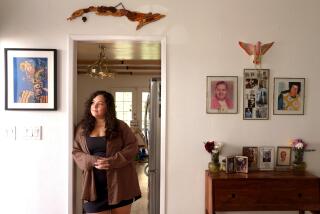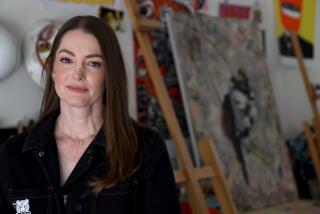Students Get the Picture About a Future in Art
- Share via
When a young child shows artistic talent, proud parents display the pretty pictures in the front window or on the refrigerator. But when the child reaches high school still consumed with the desire to be an artist, parents often object.
That is one reason the Otis Art Institute of Parsons School of Design holds a monthlong pre-college program for high school students every summer during July. Started in 1980, the program this year had 190 students from all over the country devoting a large part of their summer vacation to their first love--art.
“Most of the parents are sending their kids to art schools (after high school) against their better instincts,” said Roger Workman, dean of the school. “First and foremost on their minds is, ‘Will my son or daughter be educated or will he or she just learn to draw?’ This gives us a chance to deal with those parents a year before their students start applying to art schools.
“We try to waylay that fear that going to art school is tantamount to becoming a bum or being a waiter for the rest of the student’s life. All of our literature is aimed at the parents as much as the students about the quality of the school and that this is not a summer camp for artists.”
Especially High Demand
Otis / Parsons has a placement office that is able to place about 85% of its bachelor of fine arts graduates in the jobs they want to be in, Workman said. Graduates in fashion design are in especially high demand, followed by those in communication design and illustration. Fine arts students are more difficult to place, but Workman said most of them are not looking for full-time work and the school is active in finding them part-time work.
During the summer institute, high school school students receive college-level instruction in the basics of drawing and design. They also choose an introductory course in which they wish to specialize from a selection of fashion design, communication design, painting, illustration, interior architecture, sculpture or photography. Workman calls the pre-college session a mini-program of the first two years of the institute’s four-year bachelor of fine arts program.
“You get kids who are sure they want to be artists, others are just testing the waters,” Workman said. “They get a taste of what a fashion department is; they get a flavoring.”
Tuition for the month is $475, plus $350 for housing for about half of the students who do not live close enough to commute. Workman said the school awards about $10,000 worth of scholarships each year to students who would not otherwise be able to attend. Students receive two college credits for the program. Although a few are as young as 14, most students take the program seriously.
“I have never had any problem with discipline,” said Roy Dowell, fine arts and painting instructor. “When we had a live model come in, no one took a break for three hours.”
Most of the students enjoy the exposure to so many other artists for the first time in their lives.
‘Always the Weirdo’
“When they are in a program like this, they find identity,” said Jane Buckman, director of admissions. “Sometimes these kids are always the weirdo or always the one who draws images, but may not perform well in other subjects. Here they are with people who have the same focus. They come up with, ‘Hey, I’m really not that weird, I do have some identity, I’m creative.’ You can see the change.”
For William Martinez, 17, of Sacramento it was “like coming home.”
“I used to draw and draw and draw. I still do,” Martinez said. “In school I don’t know anyone else who wants to be a fashion designer, so I didn’t know what it was like to be around so many artists like this. I can relate to these people a lot.”
The students come in at all levels, Dowell said, and learn a great deal from watching each other. The fact that some students return for another summer is an indication to him that the program is a success.
“We introduce them to what painting is all about--that it is not just putting on paint, but that it takes thought and work and technique,” Dowell said.
Much of the program is practical, with about two-thirds of the students choosing to study designing professions. Students in graphic communication teamed up to design three complete cereal boxes--one for children, one for adults and one health cereal. They also created a health cereal, which they then photographed for advertising.
Artists as Well as Educators
They conducted a survey in stores and did studies on where products are placed on the shelf and why. They also designed record album covers and created greeting cards and gift wrapping.
Most of the teachers are professional artists as well as educators. Other professionals are brought in to speak to the students and critique their work. Janet Gane, graphic designer and instructor, teaches her students the practicalities of being an artist, such as having them work in teams because professionals seldom work independently.
“As an artist, there are not a lot of places to make a living anymore. I teach them to take their background in fine arts and project it, to make it three-dimensional,” Gane said. “If you don’t know marketing, what you design will never hit your market.”
One of the stars of the communication design department is Fidel Santana, 15, of La Mirada, who won a scholarship to the school, $1,000 and a trip to Washington for him and his parents for winning the Music Center’s Mercado ’86 poster designing contest.
“I am learning a lot,” Santana said, “getting a lot of experience in the commercial art field. I never even knew what a portfolio was until I came here.” A portfolio is a selection of an artist’s work he needs when applying for admission to art schools or for jobs.
For Anna Kuperberg, 16, of Auburn, Ala., the experience has shown her that there are many different things in the field of art that she can do, “but there was no way I could get an education in art in Auburn.” She came to find out if graphic design is what she wants to do.
Retain a Specialness
“There is a percentage of students who won’t choose to be a professional designer or artist, but they will have had the education,” Buckman said. “They can go on and find employment elsewhere, but they still can have that specialness, whatever it is--that communication between yourself and that canvas or piece of paper. Whether it is once a weekend or once a month, it is still there.”
The program is a chance for most of the students to gauge their talent, to judge the competition. Many were the art student in their schools and it is a new experience for them to be challenged by others with talent as well.
But Chester Opaon of Hawaii, who at 22 was the oldest student in the summer program and a professional artist, does not look at the program as competition. Opaon’s town of Lahaina on the island of Maui got together to send him to the school because “we have never had anyone from our town who went to art school before.”
Opaon began painting about two years ago as a hobby. He has had showings of his work at galleries on the island and has sold about 26 paintings, but he had never had any training and did not understand the language of painting when he got to the school.
“When I came in the first day and Roy said he wanted us to do an abstract painting and he mentioned water and fire, I didn’t know what abstract was. I started painting the ocean and mountains,” Opaon said. “Roy came over and he said, ‘Uh, this isn’t exactly what I wanted.’ ”
Opaon ran out and bought another canvas and walked around to see what the other students were doing. He said when he came to the school, he had one style but now he feels himself progressing every day, experimenting with new techniques.
“I may not be doing the best work, but I am progressing. I came here with nothing and I’m returning home with all this knowledge,” he said. “Now when I go home and visit the galleries, I will understand it. I will be able to look at abstract paintings and understand what the artist is trying to portray.”
More to Read
The biggest entertainment stories
Get our big stories about Hollywood, film, television, music, arts, culture and more right in your inbox as soon as they publish.
You may occasionally receive promotional content from the Los Angeles Times.










